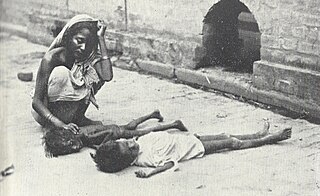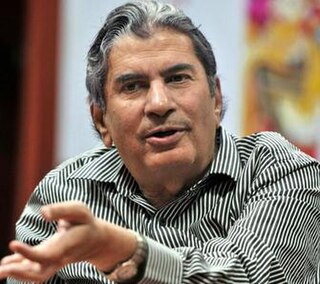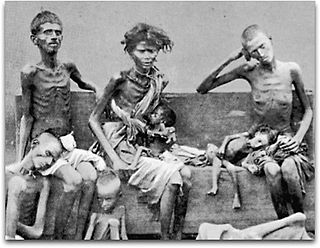
Arun Shourie is an Indian economist, journalist, author and politician. He has worked as an economist with the World Bank, a consultant to the Planning Commission of India, editor of the Indian Express and The Times of India and a Minister of Communications and Information Technology in the Vajpayee Ministry (1998–2004). He was awarded the Ramon Magsaysay Award in 1982 and the Padma Bhushan in 1990.

Kasur is a city to the south of Lahore, in the Pakistani province of Punjab. The city serves as the headquarters of Kasur District. Kasur is the 16th largest city in Punjab and 24th largest in Pakistan, by population. It is also known for being the burial place of the 17th-century Sufi-poet Bulleh Shah. It is farther west of the border with neighboring India, and bordered to Lahore, Sheikhupura and Okara Districts of Punjab. The city is an aggregation of 26 fortified hamlets overlooking the alluvial valleys of the Beas and Sutlej rivers.

The Radcliffe Line was the boundary demarcated between the Indian and Pakistani portions of the Punjab Province and Bengal Presidency of British India. It was named after Cyril Radcliffe, who, as the joint chairman of the two boundary commissions for the two provinces, had the ultimate responsibility to equitably divide 175,000 square miles (450,000 km2) of territory with 88 million people.

The Bengal famine of 1943 was an anthropogenic famine in the Bengal province of British India during World War II. An estimated 2.1–3 million people died, in the Bengal region, from starvation, malaria and other diseases aggravated by malnutrition, population displacement, unsanitary conditions and lack of health care. Millions were impoverished as the crisis overwhelmed large segments of the economy and catastrophically disrupted the social fabric. Eventually, families disintegrated; men sold their small farms and left home to look for work or to join the British Indian Army, and women and children became homeless migrants, often travelling to Calcutta or other large cities in search of organised relief.
Vir Sanghvi is an Indian print and television journalist, author, columnist and talk show host. He has been a member of many professional, academic and government bodies including the National Integration Council. Currently, he is a member of the Broadcast Content Complaint Council (BCCC), a body that regulates content on entertainment TV channels and Co-Founder/Lead Food Critic at EazyDiner. He is an opponent of the Hindutva ideology.

Vinod Mehta was an Indian journalist, editor and political commentator. He was also the founder editor-in-chief of Outlook from 1995 to 2012 and had been editor of publications such as The Pioneer, The Sunday Observer, The Independent and The Indian Post. He was also the author of several books.

Famine had been a recurrent feature of life in the South Asian subcontinent countries of India and Bangladesh, most notoriously under British rule. Famines in India resulted in millions of deaths over the course of the 18th, 19th, and early 20th centuries. Famines in British India were severe enough to have a substantial impact on the long-term population growth of the country in the 19th and early 20th centuries.

Barkha Dutt is an Indian television journalist and author. She has been a reporter and news anchor at NDTV and Tiranga TV. She currently runs her own digital news channel called 'MoJo Story'. She is also an opinion columnist with The Hindustan Times and The Washington Post.

NDTV 24x7 is a 24-hour English-language television news channel based in New Delhi, India.
Anti-Indian sentiment, a form of racism against Asians, also known as Indophobia or anti-Indianism, includes negative feelings, like hatred and disgust towards the Republic of India and Indian culture. Indophobia, in the context of anti-Indian prejudice, is "a tendency to react negatively towards people of Indian extraction, against aspects of Indian culture and normative habits". Its opposite is Indomania.

Indian Sikhs number approximately 21 million people and account for 1.7% of India's population as of 2011, forming the country's fourth-largest religious group. The majority of the nation's Sikhs live in the northern state of Punjab, which is the only Sikh-majority administrative division in the world.
Public relations is a term that refers to the management of communications between an entity such as an organization or a celebrity, and stakeholders, internal or external, such as investors, employees, communities, customers or clients. It is concerned with reputation building, and is often considered to be a subset to marketing, advertising, or corporate communications.
The Radia tapes controversy relates to the telephonic conversations between Niira Radia, a political lobbyist in India, the (then) Indian telecom minister A. Raja, and senior journalists, politicians, and corporate houses, taped by the Indian Income Tax Department in 2008–09. The tapes were leaked out to the press, and were eventually published by some media outlets and shown by television channels.
Niira Radia is a former corporate lobbyist whose taped telephone conversations implicated her influence in the allocation of key ministries in the Government of India in 2009. Discussion of the tapes resulted in the "Radia tapes controversy", which was a media event that led to the uncovering of the alleged 2G spectrum scam involving former telecommunications minister A Raja. These events led to Raja's resignation and later acquittal by Special CBI court, and Radia's departure from corporate lobbying.
Online journalism in India is a growing field shared between traditional media and the growing blogging community. Large media companies, traditionally print and television focused, continue to dominate the journalism environment now online but a growing group of dedicated bloggers are providing an independent voice.
The Kashmiris in Punjab are ethnic Kashmiris who have historically migrated from the Kashmir Valley and settled in the Punjab region. Many ethnic Muslim Kashmiris from the Kashmir Valley had migrated to the Punjab region during Sikh and Dogra rule.
Swati Chaturvedi is an Indian journalist. She has worked for various Indian newspapers and channels, like The Statesman, The Indian Express, Hindustan Times, The Tribune, NDTV, DailyO, The Wire,Gulf News and Deccan Herald. She has also published two books; her first book is Daddy's Girl; her second book is titled I am a Troll: Inside the Secret World of the BJP's Digital Army. Swati Chaturvedi won the Prize for Courage, in 2018, awarded by Reporters Without Borders for journalism in a hostile environment.
Ian Melville Stephens was a British journalist who was the editor of the Indian newspaper The Statesman in Kolkata, West Bengal, from 1942 to 1951. He became known for his independent reporting during British rule in India, and in particular for his decision to publish graphic photographs, in August 1943, of the Bengal famine of 1943, which claimed between 1.5 and 3 million lives. The publication of the images, along with Stephens' editorials, helped to bring the famine to an end by persuading the British government to supply adequate relief to the victims.

The Bengal famine of 1943-44 was a major famine in the Bengal province in British India during World War II. An estimated 2.1 million, out of a population of 60.3 million, died from starvation, malaria and other diseases aggravated by malnutrition, population displacement, unsanitary conditions, and lack of health care. Millions were impoverished as the crisis overwhelmed large segments of the economy and social fabric.









